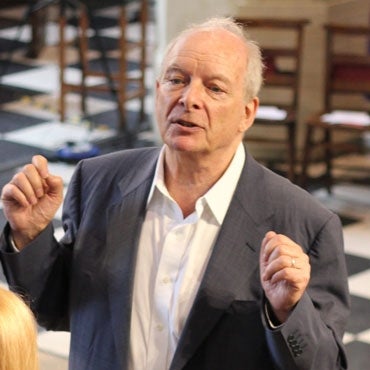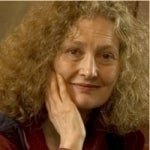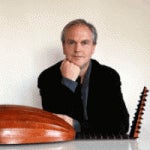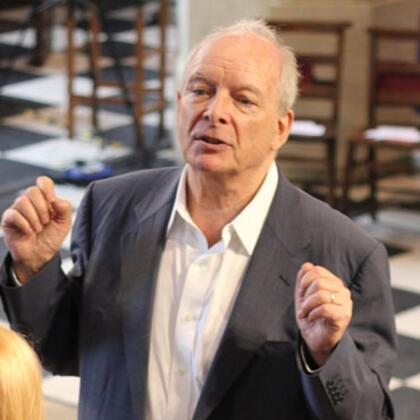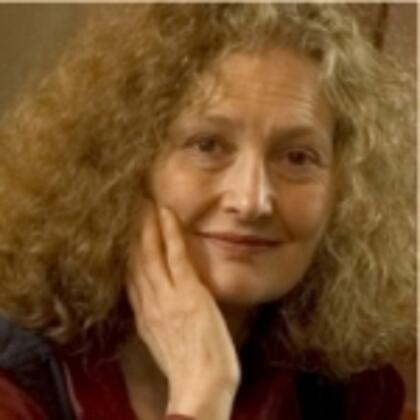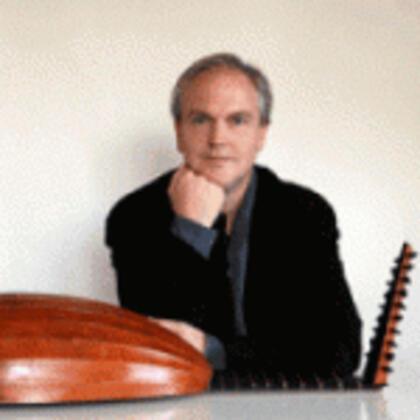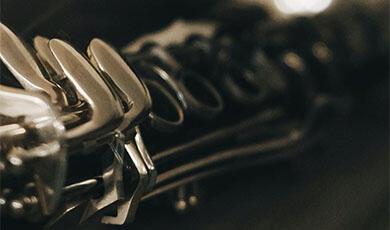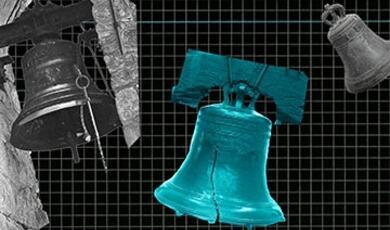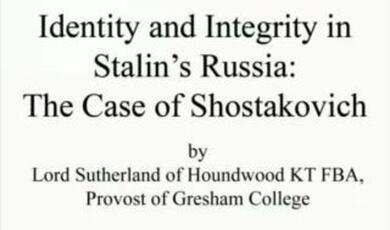From Printed Page to Performance
Share
- Details
- Text
- Audio
- Downloads
- Extra Reading
When so much in music education is formulated on the principle of imitation, and the passing down of received 'traditions' from teacher to pupil, it is important to readdress the significance of original and informed opinion in performance.
Dame Emma Kirkby, who has done more than any other musician of our generation to reassess the vocal approach to earlier music will discuss with the Lecturer her approach to singing, teaching, recording and performing and the effect her performances have had on singing world-wide over the last forty years.
The lecture is illustrated by live examples taken from Renaissance lute songs and other repertoire, including the following pieces:
John Dowland
Prelude
Go Crystal Tears
Shall I sue? Shall I seek for grace
Fantasia
Tarquinio Merula
Canzonetta Spirituale Sopra La Nanna
Henry Purcell
She loves and she confesses too
Download Text
19 April 2011
From Printed Page to Performance
Professor Christopher Hogwood in conversation with Dame Emma Kirkby and Jakob Lindberg
CH = Chris Hogwood
EK = Emma Kirkby
JL = Jakob Lindberg
CH:Good afternoon.
This is the last of my first series of Gresham lectures, and those who have been to previous events will know that we have traced music in various ways: its authenticity, its analysis, its history, the value of recordings. Last time, we caught up with the exciting business of progressing music from its dusty library into an edited form, available for the performer. For the final lecture I shall focus on what most people would consider the most important part of the music process: the actual performance. Let me introduce our two perfomers, Emma Kirkby and Jakob Lindberg.
This lecture is not entirely about performing; it is also a discussion about performance, the vicissitudes of being a performer nowadays, and the issues that occupy intelligent, famous performers when faced with this starting point of picking music off the library shelf, finding a reference, picking it from the music shop, and settling down to decide if it is for them. Will it fit their programmes? What are the pros and cons of particular volumes?
Firstly, Emma, what do you first look for when you pick something off the shelf?
EK:Well, if I am going to be singing it, I ask myself if it fits my range, am I going to be able to convey those words? Everyone has an effective speaking range and you very often find, in music of this nature, that a lot of stuff is actually written for tenor. As a result, I am always looking for things that are comfortable for me to speak, and if it looks a bit high, I check various things, depending on the piece. For example, if it is a piece in several parts, I look at the bass line in case it has got a funny cleft, because if the bass line is not in the bass cleft, it might imply that the whole thing should have been transposed down anyway. However, if you love a song regardless, there are various ways you could wriggle into the right pitch for yourself. I also check the edition – who produced this image of it, were they thinking of a piano part or something similar; really checking the provenance of the image you are looking at. If it is obviously from an original image, then I have to tell myself that this is how it is supposed to look, and I either fit it or I do not. If I know the composer already, I will have a sense of how he works. The great glory of the lute is that you can speak with it and, on the whole, the level of the text is very high. Sometimes, you can find out who wrote the poem – that is one of the many things you have to check - but in the end, you have to feel whether you can live with the song yourself, and whether someone like you should be singing it, whether its sentiments are appropriate to you as a woman, for example. That is my specific experience with lute songs. With other things, such as opera or arias, you must look at the scoring, ask yourself who else is playing, is it just strings, is there an oboe there? I love looking for chances to duet with other melody instruments. That is certainly one approach I take when sifting through a huge volume of material.
CH:Great. A little later, we shall come to the trials and joys of making programmes out of this music, because one of the features of earlier and more intimate music is that such music was not designed for concert use. We have to invent the format in which we hear it, whereas, the average symphonic programme can just combine a concerto and a symphony together on the page and there is your programme.
The job faced by an early music specialist is much like piecing together a mosaic; he or she encounters a lot of pieces averaging three minutes in length, and must construct a programme from them. We shall return to this idea shortly.
Jakob, when you look over available editions, do you find the fact that most lutenists nowadays play from tablature to be a huge advantage? Tablature, as a form of notation, manages to bypass some of the worst types of editing that a pianist can often suffer, with over-edited eighteenth-century music doctored by nineteenth and twentieth century editors – I talked about this in my last lecture. The lutenist, I suspect, has a closer and more direct path to the stuff of the original.
JL:Yes. Actually, we live in a curious time right now. We are very fortunate, in my generation, to have so many facsimile editions available to us, meaning that we can quite easily get hold of the facsimile copies of the originals. Even then, one has to be careful to some extent, and if there are other sources, like manuscripts of the same pieces, it is good to double-check that the edition that you are working from is the best possible edition. These days, a very big community of enthusiastic amateur lute players are putting all these tablatures on the internet. As a teacher, I often find that my students have downloaded tablatures put together not too cleverly by other players. This is a danger for the younger generations of players, because many of these available tablatures are, shall we say, contaminated. Of course, the fact that we can play from the same type of notation that was used back then is wonderful.
CH:So now, it seems, potentially almost everybody can be their own editor. You no longer have to rely on an edited selection of variant readings published by a professional musicologist. You can take the raw material. I think that, at the moment, lutenists are used to doing that, as are many people who deal in medieval music. Conductors who deal in historical performance are getting used to being their own editor. Standard symphonic thinking tends to sublet the job of editing to somebody else, and the orchestral player implicitly trusts what is put in front of him. This demands a certain level of understanding or trust.
Just explain though, before playing some music, the added complication of having more than one instrument around. Emma has one voice; however you describe it on the programme, it will remain that voice throughout the evening. But you can chop and change.
JL:Well, the lute is a fascinating instrument with a very long history, and there are so many different types. When choosing a programme, one has to think carefully about which lute one brings along. As a result, I often find myself deciding to travel with two, which can lead to many complications. This is particularly the case if one of those instruments is the very long theorbo - the anagram of which is, appropriately, “oh bother”! Nowadays, many airlines specify that any objects over 150cm cannot be bought a seat for and must be checked in. Conveniently, many lute-makers are now making instruments with upper necks that you can fold back, which is one solution. I do not use lutes like these, however, so I try to avoid flying with them. When I have to fly, I use an aluminium case, specially made for it, so that I can check it in without worrying too much. I designed that case after returning from a trip to Poland with Emma, only to find that the instrument had been smashed after checking it in. Therefore, if I can get away with just using one instrument, I do. Of course, this depends on the programme, and one always wants variety.
EK:We have also had fun with humidity, or should I say the lack of it?!
JL:Yes - that’s a different story!
EK:We travelled America with one of Jakob’s wondrous lutes, which dates from the late sixteenth-century. He carries around a hygrometer and doesn’t take the instrument out of its case unless the meter shows a certain reading.
JL:You need a minimum percentage of 40 really, but sometimes you can go down to 35. I have played in 35% humidity before and it has been okay. But if it goes below that, I do not take it out of the case. Half of the concert halls we visited had a humidity of 25 or 26%, so they had to boost it!
CH:Let us now consider the process of devising a programme from many small pieces – a task that is, I think in most cases, left to the performer – it is not often that a programme will be dictated to you. In the case of your first few pieces, what were your selection criteria? Why these pieces? It is obvious why you are starting with a prelude, but it is always a prelude to something.
JL:Yes. We were lucky that John Dowland wrote this particular prelude. He probably improvised these, I should think. It includes a little introductory passage on the instrument to set the sound levels and finishes on a G Major chord, which leads us very nicely into the first of the songs.
EK:This is “Go Crystal Tears”, which is one of the most perfect lyrics really – both verses fit beautifully to this quite intricate setting. You would think it was made for the first verse, but the second verse fits beautifully as well. From this, we go into “Shall I sue Shall I seek for grace?” which appears to be melancholy, but is actually a rather light love song actually.
CH: Following that, you shall play an instrumental piece, proving, I suppose, that song recitals do not have to be song followed by song followed by song.
EK:I love to make sure that there are plenty of solos. I like sitting and listening to them anyway, and I think this creates a lovely variety of sound. In this field of music, the accompanists in this are almost always fantastic soloists and deserve to be heard.
[Music plays]
CH: I am always surprised by how much skill goes into the construction of sequences like that. They seem to give such a perfect picture of a complicated composer, his various moods, the styles of the lute and so on. There are, I know from experience, so many ways such sequences can go wrong; even if one is not aware of tonality and does not have perfect pitch, you are always aware of the horrors of shifting from one key to a key a semitone or a tone higher that bears no grammatical relationship to the key before.
I think, for a long time, the world of singing was rather bedevilled by an issue that Gerald Moore addresses in his autobiography, “Am I Too Loud? The Life of an Accompanist”. He writes about concert notices from when he was young - and I am sure we can all remember them – that listed, for example, “Elizabeth Schumann, Soprano; at the Piano, Gerald Moore”. He was always very offended by this – it was not even “playing the piano”! Accordingly, a programme designed to demonstrate that Jakob is not merely “at the lute” but performing on the lute establishes the instrument within a context in which the voice is only one component.
Emma, when people write approvingly of the fact that you have founded, single-handedly, a complete school of singing, do you take that as a compliment or a limitation? A correct observation? Nowadays, we are quite used to finding, not only your voice everywhere, but clones of your voice everywhere in the early music world. Is that conceivably a school of production, of thinking, of suitability?
EK:I think clones existed in the early days, when people in charge of collegiums, particularly in American universities, would say to their students, “Please sing this like Emma Kirby.” People would come to me for coaching, girls with gorgeous olive complexions and warm Spanish-sounding voices; they would sing and I would ask, “Well, where is your voice?” – to which they would reply, “Well, I have been told to sing like you!” I would tell them: “You are the lucky possessor of a very beautiful voice. It is nothing like mine. Please use your voice! Sing like me if you want to approach the words in the same way, but please do not try and change your actual sound.” I think that is no longer the case. There are now so many good new young singers around, with really individual voices, and we can sense that they are using their own sound, which is wonderful. Singing comes from speaking, and that is how you develop an individual sound that will work for your repertoire. I really would be pleased to see more people engaging with the words, embodying them. It is not just a case of working hard on diction, like choirboys sticking their mouths out – that does not actually make the voice come comfortably at all. You have got to use your whole body, which is your instrument. You have got to find and use your core sound, after which the consonants assume a really important role. There was a very strong feeling that legato line was very important, that consonants should not be allowed to interfere as they make it very difficult to say anything. So, you have to try and balance the two. You must have that core sound, your unique sound ringing out strongly, but then you challenge it with consonants that close properly (and therefore open properly). It is very picky. You can really change the way a person sings through a line by addressing one or two syllables; it can sometimes be quite liberating, because it is terribly efficient to use the consonants very physically. It saves an awful lot of air – that is like your fuel, and so it is really worth doing.
CH: Do you find that people can actually read the words without the music, musically, and make sense of it? I am often surprised when coaching in standard conservatoires, working with singers aiming towards the operatic stage, who have got a lot for range, and you ask, “Can you just tell me the words of this aria?” They are often perplexed because, minus the music, they sometimes do not seem to remember the sequence of words, and they are certainly not able to declaim them as though they were poetry, which is where most of the music starts from.
EK:The trouble is, a composer often includes repetitions in the piece, which are wonderful in the song, but do not sound very good outside of it. The singer really has to have the shape of the poem in their head before they start, to understand precisely what teh composer has done to the original material. I think that it is very useful to ask for the words to be declaimed, because even when someone does have a grasp on the sense of the poem, they can still think that the line is very important for singing. I tell them to play an actress, rather than a singer, to speak the words but with a lot of air going through. This can be really helpful for removing vibrato at the beginning of a note, in Italian recitative for example. Let the consonant give you a clean entry, and then you can add the vibrato later on as an ornament – but it is not the first thing you hear.
CH: Going back to what you said a little bit earlier, you encourage pupils to find their natural voice, rather than try to assume a persona that they think this is correct for early music. Jakob, do you find that lute pupils still arrive at the instrument via the guitar?
JL: Yes.
CH: This can be quite a bugbear, as the instruments are completely separated in tradition. How do you ‘de-tune’ them, as it were?
JL:The theorbo is a good step towards it, because the theorbo players use nails quite often. Playing the lute in the authentic way involves using the flesh of the fingertips, which is often the first obstacle for a guitarist. I made that same decision myself, many years ago – do I cut my nails off? That is dangerous for a guitarist, so by playing a theorbo first, which saves the nails, they can get hooked and then move on to the finer point of a lute, where their touch is very different. When learning the guitar, you are taught that all fingers should sound absolutely equal, so pupils practise it in that way and they do scales. The lute, however, takes wonderful advantage of the hand. We have the caption of the fingers, the thumb, which always takes the strong beat, and then the index - which is short finger - takes the light beat; if you alternate with these two, the second finger always takes the strong beat and vice versa. There is a natural link between physical movement and musical expression, and that is something that intrigues learners because it is the opposite of what they have been taught. There is always a certain amount of “de-guitarification” to be done!
CH: I think this business of using the natural facility and differences of the body applies to many instruments. This is something that has often been denied by traditional conservatoire, where you practise the piano like mad to make your fourth finger as strong as your second finger and so on. It was never so in the seventeenth and eighteenth Centuries. It was admitted that you had good and bad fingers, which meant strong and weak fingers, which gave an automatic inflection to the playing.
Just the same as it was assumed, when you play the violin, that the down-bow is strong and the up-bow - the return bow - is lighter, which gave the plasticity to the line that you played. With more recent training, particularly Russian training for violinists, the Julliard up-bow is several times louder than the Julliard down-bow, I find! It is completely counter to nature that you must really work on kids who have learnt this style to make a virtue of the inequality.
While we are on the teaching subject, let me pose to you the following scenario. Recently, a boy came to me who had been criticised for his playing of a Mozart sonata in a competition. He had been criticised for playing the piece technically perfectly, but was told that he “lacked insight” - he wanted to know now where he should go and to whom to gain this “insight”! How can one see into this world of Elizabethan or Jacobean music? Can it be done by teaching, or is it more a case of osmosis and an interest in that entire area of civilisation?
EK:I think that is the more effective way, obviously; what people have found out for themselves is always going to sink in dee
CH: Well, he has to communicate something. If it is a case of “You are feeling more than you are communicating,” then that is certainly teachable, in the same way that you can teach acting expression. When the full feeling is in there, you can sense it, but it does not actually communicate. I just wonder whether insight is something different from mere experience or a sense of experiment?
EK:I vividly remember a very nice Italian professor, who was so sympathetic and helpful. I was singing Monteverdi with all the passion I could muster, and he said, “Yes, it is going very nicely, but I don’t get much feeling yet”! He was right because it was actually all in my head and not in my body, which is really the point. You have got to use your whole body. For your boy playing Mozart on the piano, I suppose the solution would have to the physical involvement of the body, somehow? You have got to give a bit more away and live more dangerously. Of course, it is very hard for young people to live dangerously without making a mess, which they do not want to do!
CH: One of the main reasons for being slightly petrified at the modern keyboard is the sense that the instrument you are using is not exactly appropriate to the repertoire you are playing. The player enters a frozen state of not wanting to overdo the Steinway Grand for fear that the purity police will come along and complain that they have overstepped the mark. To play on an appropriate instrument, where you can really go to its limits, where you can play Mozart’s sonata using the very lowest and the very highest note - that is very good. The only other suggestion I could make to the boy is that he should not only experiment a little on instruments closer to Mozart’s intention, but he should also not incline towards the setting of a modern concert hall. That is surely the problem you both face, of setting up recitals and performances in buildings that are too big, with an audience of too many thousand, far too many people to project to at once. If he cut down his Mozart to the sound of a clavichord, perhaps, and played for three friends, then he migper. I feel very sorry for your questioner, I must say. It is so easy to say things like that about a performance, that it lacks passion or it lacks permission. You wonder how you can know what is going on inside that performer, because that it is a very subtle question. It is very difficult.ht be nearing that “insight.” Emma, presumably you have to turn down jobs asking you to sing unaccompanied in the Albert Hall?!
EK:Yes! I remember I was booked to sing in a really beautiful hall in Guilford, and someone came up to me and said, “The concert is already sold out and I am under pressure to move it into the church where you sang Mozart last year. What do you think?” I said that it would not work, and he was very relieved by my answer. He really did not want to have to do that. You can obviously do things to create some degree of domestic feeling to draw people in, wherever you are, but there is a limit to how far you can go with that.
CH: Jakob, since you have described the “Oh bother”, this might be an opportunity to move onto that instrument!
JL:Yes, here it is… It was invented in Italy, developed from a bass lute - the largest lute - and this idea of the extended neck came later. The six strings that you play most of the music on are tuned in a so-called re-entrant tuning. The two top strings have been dropped an octave, and then you have just a scale down there for the long strings. The man who invented it was Alessandro Piccinini. He wanted to make a lute sound with stronger bass, and the first attempt was to make a very big instrument, like this, and he had one bridge here and another bridge down here to make the long bass, but that turned out to be impossible to play. So, he came up with this idea, which is impossible to tune!
EK:We are going to start with the minimum theorbo experience - the first few bars. It is the most amazing bass line.
[Music plays]
EK:“La Nanna” is a lullaby – it is the Virgin lulling Jesus to sleep, and saying, “Please, you must sleep now, and you must not cry, because there shall be plenty of reasons to cry later.” It involves a lot of irony and it is very enchanting and bleak and beautiful. It also takes a long tiem to play, as a lullaby, so we are only going to give you an impression of it. We have made a little tuck in the middle. Repetition is an essential part of lullabies – babies have to hear the same things many, many times, otherwise they will not go to sleep. In this case, the hypnotic thing is the bass line. At the lullaby’s end, once the baby has fallen asleep, you will hear the Virgin ask, “Now he’s asleep, what do I do? All I can do is just watch and revere him.”
[Music plays]
Part of:
This event was on Tue, 19 Apr 2011
Support Gresham
Gresham College has offered an outstanding education to the public free of charge for over 400 years. Today, Gresham College plays an important role in fostering a love of learning and a greater understanding of ourselves and the world around us. Your donation will help to widen our reach and to broaden our audience, allowing more people to benefit from a high-quality education from some of the brightest minds.


 Login
Login
